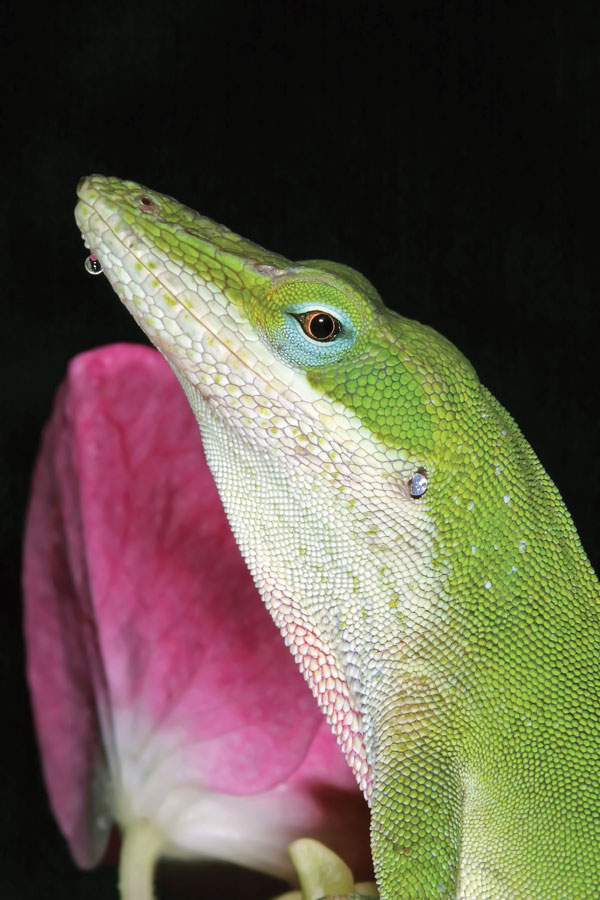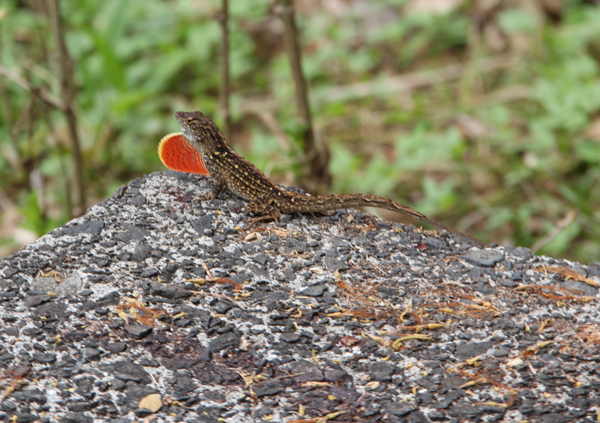These anoles can make great pet lizards.
The green anole (Anolis carolinensis) is certainly not the only anole species available for the home terrarium. A much larger species–one that must be housed individually–is the Cuban knight anole (Anolis equestris). Growing to more than 18 inches in length and sporting powerful jaws and keen eyes, the Cuban knight anole is the largest anole species on the planet. This fiercely aggressive species is very attractive; coloration is light to dark green in base with yellow to blue highlights over the body and head. Best suited for more advanced hobbyists, the knight anole feeds on large crickets, super- or king-mealworms and even small mice. As you might imagine, the knight anole requires a proportionally large terrarium and temperatures between 83 degrees Fahrenheit toward the cool end and 90 degrees under the hot spot.

shutterstock/john r. mcnair
The green anole is easily one of the most popular lizards in the reptile hobby.
The brown anole (Anolis sagrei) is a much smaller and more manageable species in the home terrarium. Adults seldom exceed 6 inches in length, and wear a basal coat of chocolate brown with lighter brown highlights and a bright, crimson dewlap. Easily kept in small or large colonies, the brown anole should be housed with an ambient temperature between 82 and 86 degrees and a basking spot of up to 95 degrees.

Photo by John B. Virata
The brown anole should be housed with an ambient temperature between 82 and 86 degrees and a basking spot of up to 95 degrees.
Offer them plenty of wood decor to perch on. One of the more terrestrial of the anole species, the brown anole seldom lives more than a few feet off the ground. Thus, secured driftwood or slabs of cork bark, leaned upright against the wall of the terrarium, function well as climbs and hides for this chocolate-colored species. A native of the tropical islands of the Caribbean, the brown anole requires a higher level of relative humidity (60 to 70 percent) if it is to thrive in the home terrarium. Often sold in pet shops as a feeder for larger reptile species, the brown anole might be the least expensive anole species available today.
Perhaps the most stunningly beautiful species of anole available on the pet trade is Anolis garmani, the Jamaican giant anole. Wearing a basal color of emerald green with a row of uniform spines starting at the base of the skull and running down the midline of the back, this heavy-bodied anole is a robust and strikingly attractive animal. Sporting one of the most pure and even greens to be found in the reptile-world, the Jamaican giant is a true beauty. When displaying against rival males or attracting females during mating season, male Jamaican giants will flare large, canary-yellow dewlaps. As you might imagine, the Jamaican giant anole is not as inexpensive as some of its smaller cousins; this wonderful lizard typically fetches $50 to $75.
There are numerous other species of anole available for the reptile hobbyist. All sizes dispositions, and colors are available. As more and more anole enthusiasts get involved with these animals, importers and private breeders are able to supply the pet trade with larger (and therefore less expensive) numbers of formerly rare species. The anoles are a wonderfully diverse family of lizards; keep searching their ranks and find the species that are right for you and your home terrarium.


